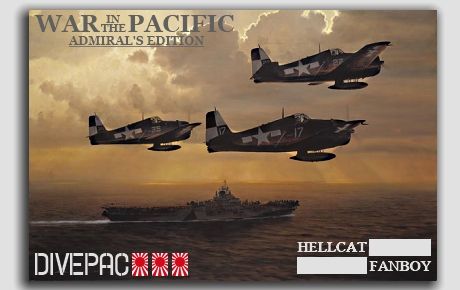Kull
Posts: 2625
Joined: 7/3/2007
From: El Paso, TX
Status: offline

|
Changes in Version "E" (Various strategic/tactical improvements & formats revised to match "Japan Set-up")
1) Format & Terminology changes:
A lot of changes were made to format in order to fully align the "Allies Set-up" worksheet with it's Japan counterpart. You'll also notice that the color coding is identical, as are the expanded data fields (columns M-AH) imported from Tracker. Much of this isn't immediately apparent, but users of both spreadsheets will now find them to be almost fully in synch.
The comments section was extensively revised in order to use terminology "shortcuts" that are identical to those in the Japanese version. For example:
Original ASW Patrol Settings: ASW Patrol, Search: 310-40, Level: 50, Alt: 5K, Train: 20 (all else no change)
New "Japan-style" Description: ASW Patrol (50): 310-40, Alt: 5K, Train: 20
2) Naval Air Units:
Air units aboard ship now have their own "data row" (same as the Japan spreadsheet)
3) Veteran Pilot Reallocation Process:
The previous version of the spreadsheet contained detailed recommendations on how many Veteran Pilots should be harvested and moved from one unit to another, literally noting how many pilots should be pulled from unit "X" and reassigned to units "Y & Z". On further consideration, that's too much micro-management for a "getting started" spreadsheet. All that is gone, replaced by an occasional notation for any unit that might benefit from adding replacements or even swapping in some Veteran Pilots (in general, that would be any pilot with 60+ experience).
4) Allied Pilot Training:
A major change in the new version is a much larger number of air units assigned to Training missions. Most Allied pilots begin the game with very low experience and their across-the-board specialized skill numbers are frequently atrocious. Accordingly, the number of air units flying missions (Naval Search and ASW Patrols in particular) have been greatly reduced so you can get an early start on building up those important skill sets.
5) Submarine Patrol Zones:
I have provided specific Patrol Zones for most submarines, but it can be very time consuming to match them exactly. Accordingly, you should feel free to set your own zones, or simply note the designated area for each zone - always specified in the Comments - and then use the "Patrol Around Target" button. The resulting computer choices are often less than optimal, but are easy to alter in the Patrol Zone selection screen. Tip: When using the "Patrol Around Target" button, do not select any land hex. For some reason that sets only two patrol zone points, whereas selecting an ocean hex gives three.
The AI doesn't deal with enemy subs as well as a Human player, so to reduce their impact a bit, Submarine Reaction limits are always kept at "1"
6) Actions/Descriptions for Damaged Units:
The previous version provided comments based on the "after Day 1" state of all units, to include those damaged in the various Japanese attacks. However, even with the "Historical First Turn" toggled on, the results of these attacks are highly variable - especially the list of ships that are sunk, and even the damage levels on those which survive. Some air units can also be damaged so severely as to have few flying airframes. Pearl Harbor is the primary example, but similar issues affect the Philippines, Burma, & Malaya.
Accordingly, the new spreadsheet assumes all units are present and undamaged, but does try to minimize the assignment of actions to those likely to be impacted. You will just have to go through each port and airfield and make adjustments according to the true state of affairs in your game.
7) Historical Game Play Considerations:
WitP-AE is not a simulation, and there is no requirement for the human player to try and "replicate history". However, there are certain areas where I find the game is improved if you impose limitations on what the engine otherwise allows. Specifically:
7a) Several changes to the China Theatre:
Certain Chinese units are no longer recommended to move outside of China (except for possible offensive action against Japanese units in Border zones) unless PPs are paid to release them. Basically it's a gameplay/historical improvement - in particular to avoid the temptation of building up a non-historical defense force in Burma. There is no code which would prevent you from just marching them over the border (for free), but it's a better game if you don't.
Although there's no way to visibly distinguish Red Chinese from Kuomintang forces (to say nothing of trying to separate Chiang Kai Shek loyalists from the Warlords leading their own private armies), I've tried to add some additional realism by not grouping the two together. In sum, the game has some Kuomintang armies in Yenan (the communist capital) while two Red Chinese units occupy Sian (a Kuomintang city). Units that are moving only for this reason will contain a simple notation in the comment column ("Communist" or "Kuomintang"), so players who do not care for this level of granularity can simply ignore the movement instructions given to those units. This was the result of a pretty detailed analysis on the affiliation of in-game units:
7b) ABDA Command:
Historically, the "American-British-Dutch-Australian" command system was not finalized until very late December. Accordingly, the new version of the spreadsheet actively avoids combinations of forces that would not have taken place until that time. So no mixed Naval, Ground, or Air Forces forces from the outset - in particular ANY combination involving the Dutch - until January 1st.
This does not apply to Cargo ships and escorts moving fuel or supply (but it does apply to Troop Transports), or to existing Allies like Britain-Commonwealth-Australia-NZ, nor also the Australian-US strategic cooperation that began very shortly after the Pacific War commenced. More problematic is British-US cooperation. Although already coordinating closely in the Atlantic, the US was very concerned about appearing to support British colonial activities in the Far East, and actively avoided doing so throughout the war. So aside from Naval Task force combinations, the spreadsheet deliberately avoids combined land and air operations involving the US and Britain (AVG being the sole exception, for historical reasons). The same "colonial conundrum" likewise bars the movement of US land forces into Dutch possessions, while British/Australian/NZ land forces never move to Dutch bases as politically those countries were far more concerned about homeland (or "own colony") defenses.
It should also be remembered that the purpose of ABDA was to defend the "Malay Barrier" (which extended through the southern islands of the Dutch East Indies), not facilitate it's evacuation. Accordingly, I've reduced (or added significant "degree of difficulty") to all "Brave Sir Robin" activities. This means:
- Evacuating units from the North Coast of Borneo (or from Hong Kong), now requires British-owned ships, bases, and air transports. No more pull-outs using Dutch or US air and sea units (nor into into Dutch or US bases)
- Likewise, no more buying out of Dutch units for use in Australia or other theatres. Moving them in limited numbers to Dutch-owned bases that are closer to Australia is OK, since that is in accordance with the ABDA charter.
- Although not strictly related to ABDA, the wholesale evacuation of US units from the Philippines has also been significantly curtailed. Gen. Douglas MacArthur commanded this theatre, and historically would NEVER have supported a major reduction in ground forces - quite the contrary, he was pushing for more. Air and Naval units are a different matter, as historically they were pulled out early in the campaign.
Obviously you can choose to ignore all these limitations, but please remember that it's very easy to break the AI early in the war, especially when the human player can use all sorts of historically impossible force combinations ("Fortress Palembang" and "Fortress Java" in particular). You want to have a fun game here, and the best way to do that is to impose the actual historical limits on your options, thereby giving the AI a decent chance to grab the bases it needs to support the Japanese economy in the years to come. Strategies that are totally "OK" against a human player (who can react to them) will strangle the script-driven AI before it even has a chance to get going.
7c) American Pilot Considerations (AVG & Philippines):
The AVG (literally the "All Volunteer Group") was composed of civilians operating under contract, and realistically the player should not treat these pilots like the rest of the American pilot pool. You start the war with 79 pilots assigned to the 3 AVG units in Burma, but since there were originally 99 under contract, it's historically reasonable to add 20 more into the AVG pool.....but no more until such time as the units withdraw. For similar reasons, these units should restrict their movement to bases in Burma and China, as was historically true.
During the early part of the war the US was not able to easily move pilots in or out of the Philippines theatre of operations. Certainly not as easily as one can by using the Pilot replacement buttons. To play as historically as possible, the human player should NOT move veteran pilots in (or out) of these units, at least until the end of December. That would reflect the early war chaos, after which the player should feel free to take whatever actions seem appropriate.
As always, these are only recommendations and the player can choose to operate differently.
NOTE: If you are interested in some eye candy, in April 2020 I completed a mod which provides historically accurate shapes, colors, and camouflage for 135 classes of Japanese ships, primarily Auxiliaries, Transports and Cargo ships. If you are interested in the historical background behind each and every one of these vessels, there's an interesting thread which takes you through the development process. For the mod itself, this link has the download and full installation instructions. As the Allies, you'll only see all the new shipsides when you are attacking a Japanese Task Force, but it does add some spice when your Submarines or Dive Bombers are taking aim at a beautifully camouflaged Japanese vessel!
< Message edited by Kull -- 6/12/2020 5:18:29 PM >
|
 Printable Version
Printable Version
















 And also to the 72 folks (and counting) who've already downloaded it! As I play further into the game, I'll come back and create revisions if it turns out that some of my force dispositions are....less than optimal! So far it's already obvious that AI-KB's tendency to loiter around Pearl Harbor means that most of my recommended TFs there are little more than suicide missions. Plus, I'm pretty sure that I can improve the West Coast Search & ASW net. Otherwise it seems to be playing out rather well.
And also to the 72 folks (and counting) who've already downloaded it! As I play further into the game, I'll come back and create revisions if it turns out that some of my force dispositions are....less than optimal! So far it's already obvious that AI-KB's tendency to loiter around Pearl Harbor means that most of my recommended TFs there are little more than suicide missions. Plus, I'm pretty sure that I can improve the West Coast Search & ASW net. Otherwise it seems to be playing out rather well. 







 New Messages
New Messages No New Messages
No New Messages Hot Topic w/ New Messages
Hot Topic w/ New Messages Hot Topic w/o New Messages
Hot Topic w/o New Messages Locked w/ New Messages
Locked w/ New Messages Locked w/o New Messages
Locked w/o New Messages Post New Thread
Post New Thread